Music Laws: Copyright, Royalties, and Digital Distribution Analysis
VerifiedAdded on 2020/03/04
|6
|1530
|312
Report
AI Summary
This report delves into various aspects of music law, focusing on copyright, royalties, and digital distribution. It examines the legal implications of joint ownership in songwriting, clarifying how copyright is protected in Australia and the rights of different stakeholders (composer, lyricist, performer, and sound recording owner). The report then explores digital distribution through aggregators, detailing the services they provide, using DistroKid as an example, and comparing them to direct uploads to platforms like iTunes. Finally, it analyzes royalty systems, explaining how songwriters and recording artists earn royalties from different sources (public performance, sales) and provides a calculation example, considering factors like the published price to dealer, royalty rates, and deductions. The report concludes by emphasizing the importance of understanding royalty systems and costs for artists to maximize their earnings.
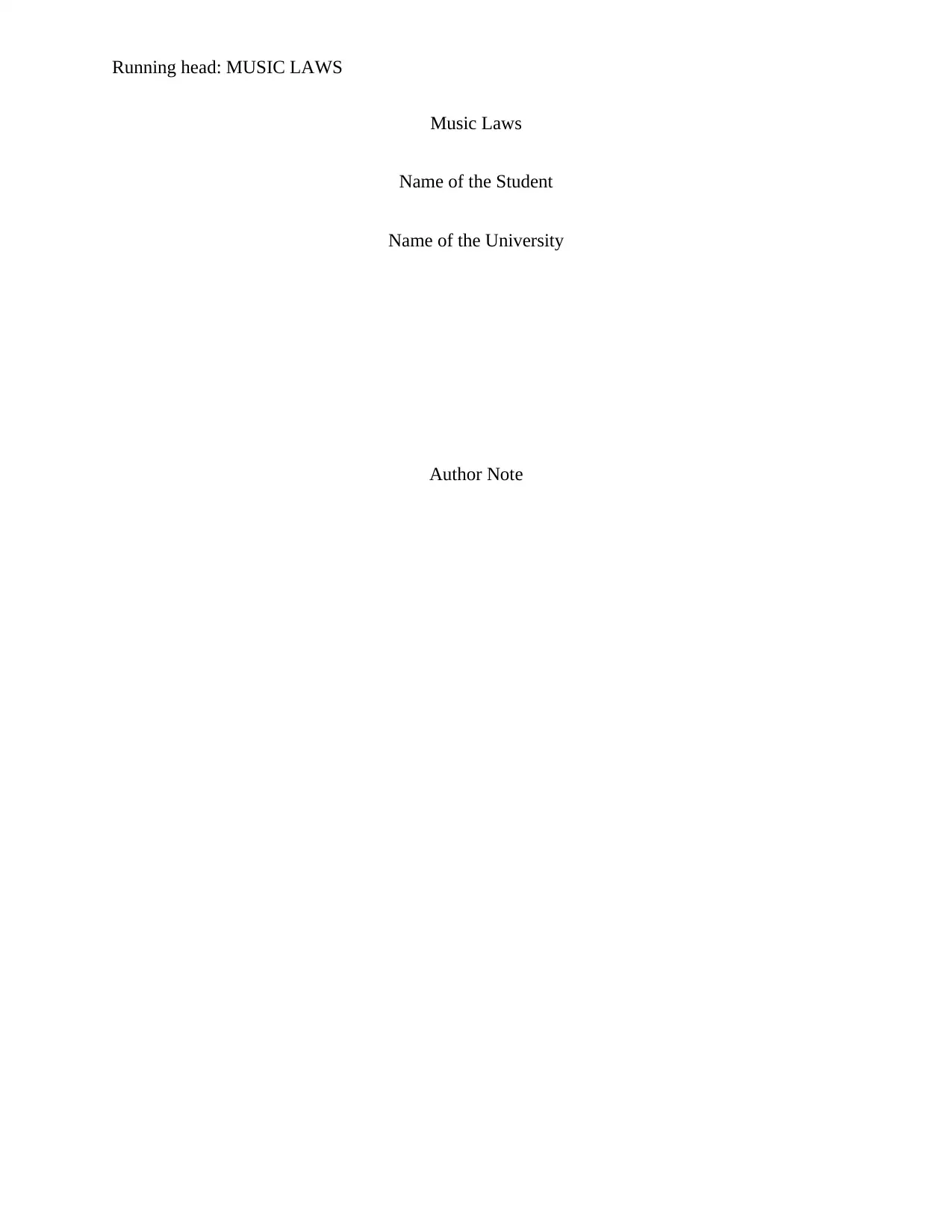
Running head: MUSIC LAWS
Music Laws
Name of the Student
Name of the University
Author Note
Music Laws
Name of the Student
Name of the University
Author Note
Paraphrase This Document
Need a fresh take? Get an instant paraphrase of this document with our AI Paraphraser
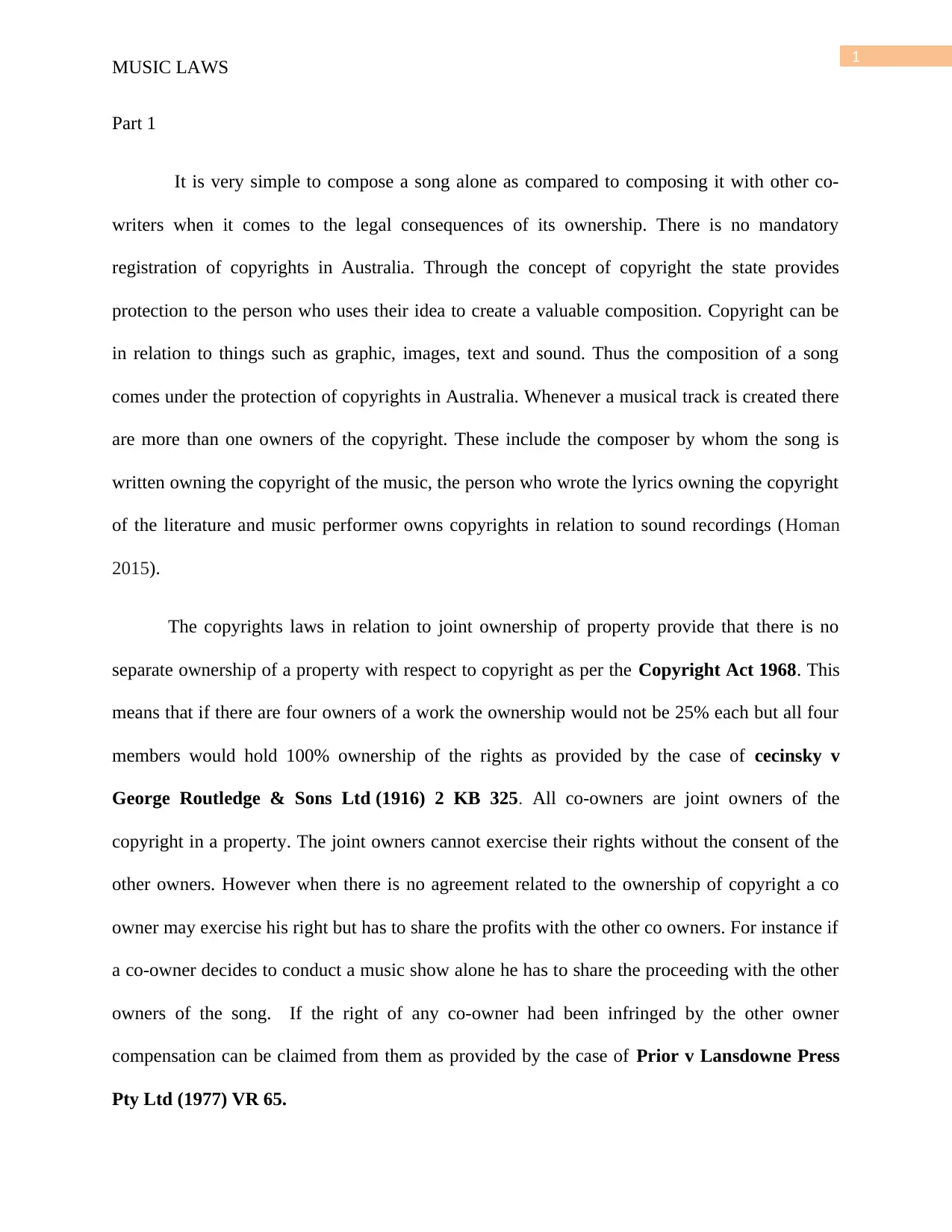
1
MUSIC LAWS
Part 1
It is very simple to compose a song alone as compared to composing it with other co-
writers when it comes to the legal consequences of its ownership. There is no mandatory
registration of copyrights in Australia. Through the concept of copyright the state provides
protection to the person who uses their idea to create a valuable composition. Copyright can be
in relation to things such as graphic, images, text and sound. Thus the composition of a song
comes under the protection of copyrights in Australia. Whenever a musical track is created there
are more than one owners of the copyright. These include the composer by whom the song is
written owning the copyright of the music, the person who wrote the lyrics owning the copyright
of the literature and music performer owns copyrights in relation to sound recordings (Homan
2015).
The copyrights laws in relation to joint ownership of property provide that there is no
separate ownership of a property with respect to copyright as per the Copyright Act 1968. This
means that if there are four owners of a work the ownership would not be 25% each but all four
members would hold 100% ownership of the rights as provided by the case of cecinsky v
George Routledge & Sons Ltd (1916) 2 KB 325. All co-owners are joint owners of the
copyright in a property. The joint owners cannot exercise their rights without the consent of the
other owners. However when there is no agreement related to the ownership of copyright a co
owner may exercise his right but has to share the profits with the other co owners. For instance if
a co-owner decides to conduct a music show alone he has to share the proceeding with the other
owners of the song. If the right of any co-owner had been infringed by the other owner
compensation can be claimed from them as provided by the case of Prior v Lansdowne Press
Pty Ltd (1977) VR 65.
MUSIC LAWS
Part 1
It is very simple to compose a song alone as compared to composing it with other co-
writers when it comes to the legal consequences of its ownership. There is no mandatory
registration of copyrights in Australia. Through the concept of copyright the state provides
protection to the person who uses their idea to create a valuable composition. Copyright can be
in relation to things such as graphic, images, text and sound. Thus the composition of a song
comes under the protection of copyrights in Australia. Whenever a musical track is created there
are more than one owners of the copyright. These include the composer by whom the song is
written owning the copyright of the music, the person who wrote the lyrics owning the copyright
of the literature and music performer owns copyrights in relation to sound recordings (Homan
2015).
The copyrights laws in relation to joint ownership of property provide that there is no
separate ownership of a property with respect to copyright as per the Copyright Act 1968. This
means that if there are four owners of a work the ownership would not be 25% each but all four
members would hold 100% ownership of the rights as provided by the case of cecinsky v
George Routledge & Sons Ltd (1916) 2 KB 325. All co-owners are joint owners of the
copyright in a property. The joint owners cannot exercise their rights without the consent of the
other owners. However when there is no agreement related to the ownership of copyright a co
owner may exercise his right but has to share the profits with the other co owners. For instance if
a co-owner decides to conduct a music show alone he has to share the proceeding with the other
owners of the song. If the right of any co-owner had been infringed by the other owner
compensation can be claimed from them as provided by the case of Prior v Lansdowne Press
Pty Ltd (1977) VR 65.
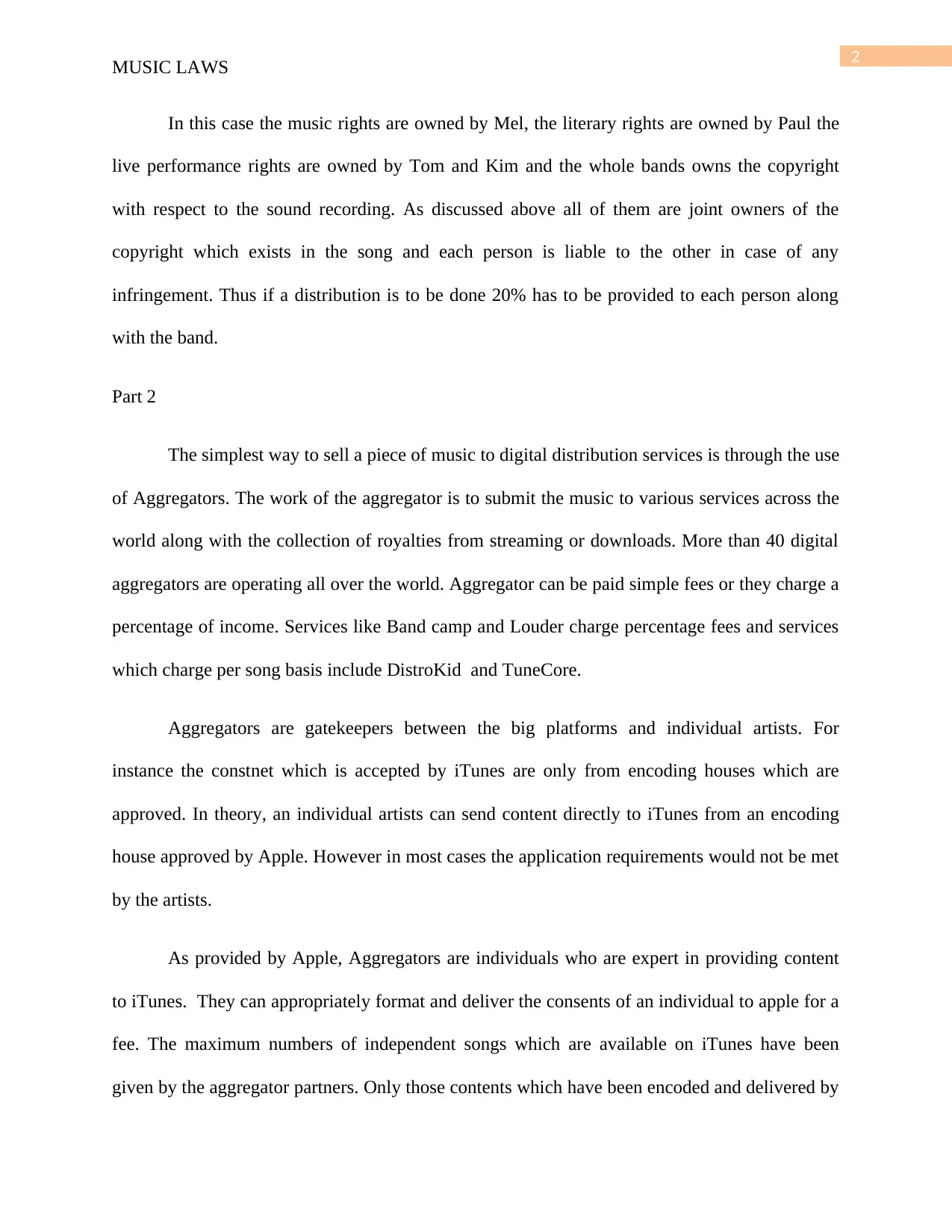
2
MUSIC LAWS
In this case the music rights are owned by Mel, the literary rights are owned by Paul the
live performance rights are owned by Tom and Kim and the whole bands owns the copyright
with respect to the sound recording. As discussed above all of them are joint owners of the
copyright which exists in the song and each person is liable to the other in case of any
infringement. Thus if a distribution is to be done 20% has to be provided to each person along
with the band.
Part 2
The simplest way to sell a piece of music to digital distribution services is through the use
of Aggregators. The work of the aggregator is to submit the music to various services across the
world along with the collection of royalties from streaming or downloads. More than 40 digital
aggregators are operating all over the world. Aggregator can be paid simple fees or they charge a
percentage of income. Services like Band camp and Louder charge percentage fees and services
which charge per song basis include DistroKid and TuneCore.
Aggregators are gatekeepers between the big platforms and individual artists. For
instance the constnet which is accepted by iTunes are only from encoding houses which are
approved. In theory, an individual artists can send content directly to iTunes from an encoding
house approved by Apple. However in most cases the application requirements would not be met
by the artists.
As provided by Apple, Aggregators are individuals who are expert in providing content
to iTunes. They can appropriately format and deliver the consents of an individual to apple for a
fee. The maximum numbers of independent songs which are available on iTunes have been
given by the aggregator partners. Only those contents which have been encoded and delivered by
MUSIC LAWS
In this case the music rights are owned by Mel, the literary rights are owned by Paul the
live performance rights are owned by Tom and Kim and the whole bands owns the copyright
with respect to the sound recording. As discussed above all of them are joint owners of the
copyright which exists in the song and each person is liable to the other in case of any
infringement. Thus if a distribution is to be done 20% has to be provided to each person along
with the band.
Part 2
The simplest way to sell a piece of music to digital distribution services is through the use
of Aggregators. The work of the aggregator is to submit the music to various services across the
world along with the collection of royalties from streaming or downloads. More than 40 digital
aggregators are operating all over the world. Aggregator can be paid simple fees or they charge a
percentage of income. Services like Band camp and Louder charge percentage fees and services
which charge per song basis include DistroKid and TuneCore.
Aggregators are gatekeepers between the big platforms and individual artists. For
instance the constnet which is accepted by iTunes are only from encoding houses which are
approved. In theory, an individual artists can send content directly to iTunes from an encoding
house approved by Apple. However in most cases the application requirements would not be met
by the artists.
As provided by Apple, Aggregators are individuals who are expert in providing content
to iTunes. They can appropriately format and deliver the consents of an individual to apple for a
fee. The maximum numbers of independent songs which are available on iTunes have been
given by the aggregator partners. Only those contents which have been encoded and delivered by
⊘ This is a preview!⊘
Do you want full access?
Subscribe today to unlock all pages.

Trusted by 1+ million students worldwide
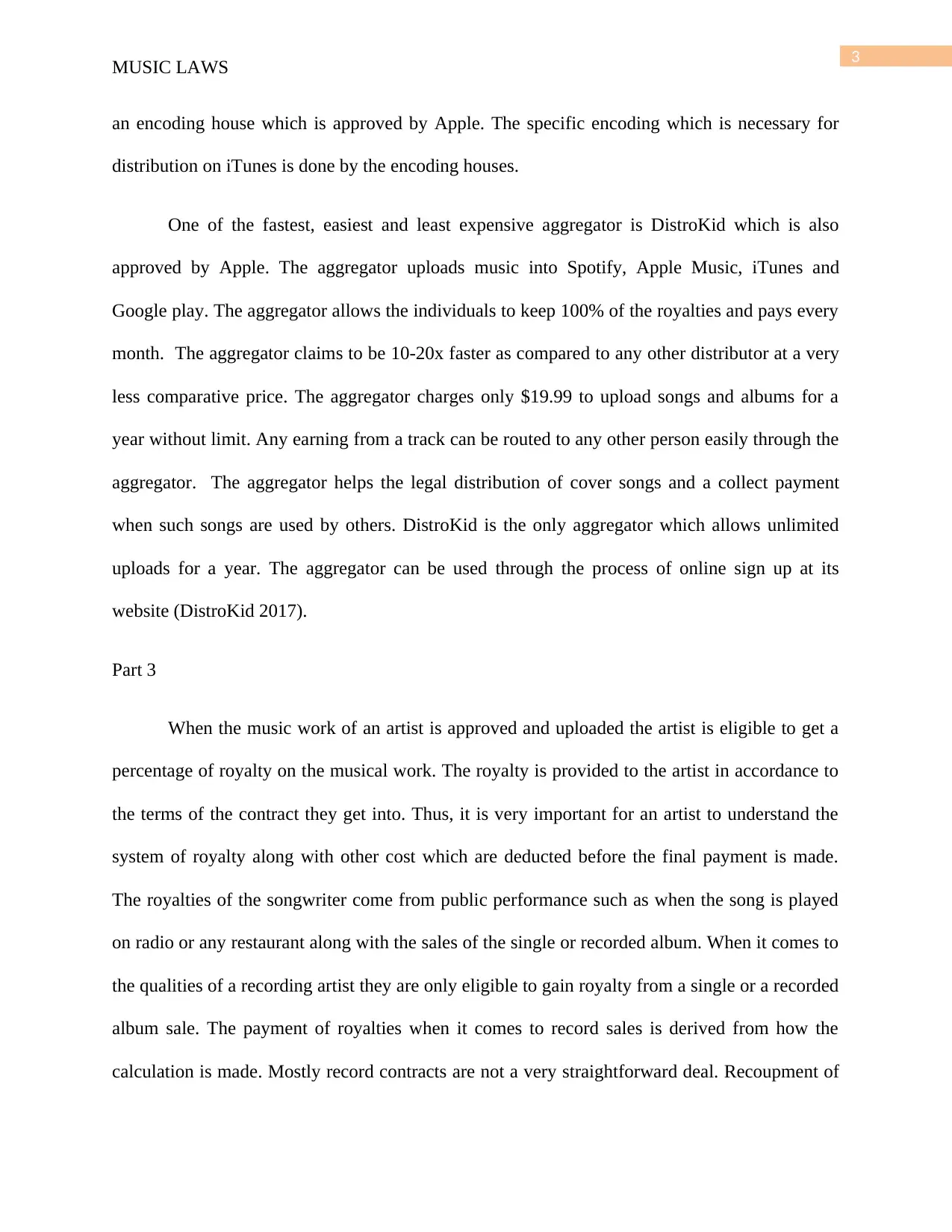
3
MUSIC LAWS
an encoding house which is approved by Apple. The specific encoding which is necessary for
distribution on iTunes is done by the encoding houses.
One of the fastest, easiest and least expensive aggregator is DistroKid which is also
approved by Apple. The aggregator uploads music into Spotify, Apple Music, iTunes and
Google play. The aggregator allows the individuals to keep 100% of the royalties and pays every
month. The aggregator claims to be 10-20x faster as compared to any other distributor at a very
less comparative price. The aggregator charges only $19.99 to upload songs and albums for a
year without limit. Any earning from a track can be routed to any other person easily through the
aggregator. The aggregator helps the legal distribution of cover songs and a collect payment
when such songs are used by others. DistroKid is the only aggregator which allows unlimited
uploads for a year. The aggregator can be used through the process of online sign up at its
website (DistroKid 2017).
Part 3
When the music work of an artist is approved and uploaded the artist is eligible to get a
percentage of royalty on the musical work. The royalty is provided to the artist in accordance to
the terms of the contract they get into. Thus, it is very important for an artist to understand the
system of royalty along with other cost which are deducted before the final payment is made.
The royalties of the songwriter come from public performance such as when the song is played
on radio or any restaurant along with the sales of the single or recorded album. When it comes to
the qualities of a recording artist they are only eligible to gain royalty from a single or a recorded
album sale. The payment of royalties when it comes to record sales is derived from how the
calculation is made. Mostly record contracts are not a very straightforward deal. Recoupment of
MUSIC LAWS
an encoding house which is approved by Apple. The specific encoding which is necessary for
distribution on iTunes is done by the encoding houses.
One of the fastest, easiest and least expensive aggregator is DistroKid which is also
approved by Apple. The aggregator uploads music into Spotify, Apple Music, iTunes and
Google play. The aggregator allows the individuals to keep 100% of the royalties and pays every
month. The aggregator claims to be 10-20x faster as compared to any other distributor at a very
less comparative price. The aggregator charges only $19.99 to upload songs and albums for a
year without limit. Any earning from a track can be routed to any other person easily through the
aggregator. The aggregator helps the legal distribution of cover songs and a collect payment
when such songs are used by others. DistroKid is the only aggregator which allows unlimited
uploads for a year. The aggregator can be used through the process of online sign up at its
website (DistroKid 2017).
Part 3
When the music work of an artist is approved and uploaded the artist is eligible to get a
percentage of royalty on the musical work. The royalty is provided to the artist in accordance to
the terms of the contract they get into. Thus, it is very important for an artist to understand the
system of royalty along with other cost which are deducted before the final payment is made.
The royalties of the songwriter come from public performance such as when the song is played
on radio or any restaurant along with the sales of the single or recorded album. When it comes to
the qualities of a recording artist they are only eligible to gain royalty from a single or a recorded
album sale. The payment of royalties when it comes to record sales is derived from how the
calculation is made. Mostly record contracts are not a very straightforward deal. Recoupment of
Paraphrase This Document
Need a fresh take? Get an instant paraphrase of this document with our AI Paraphraser
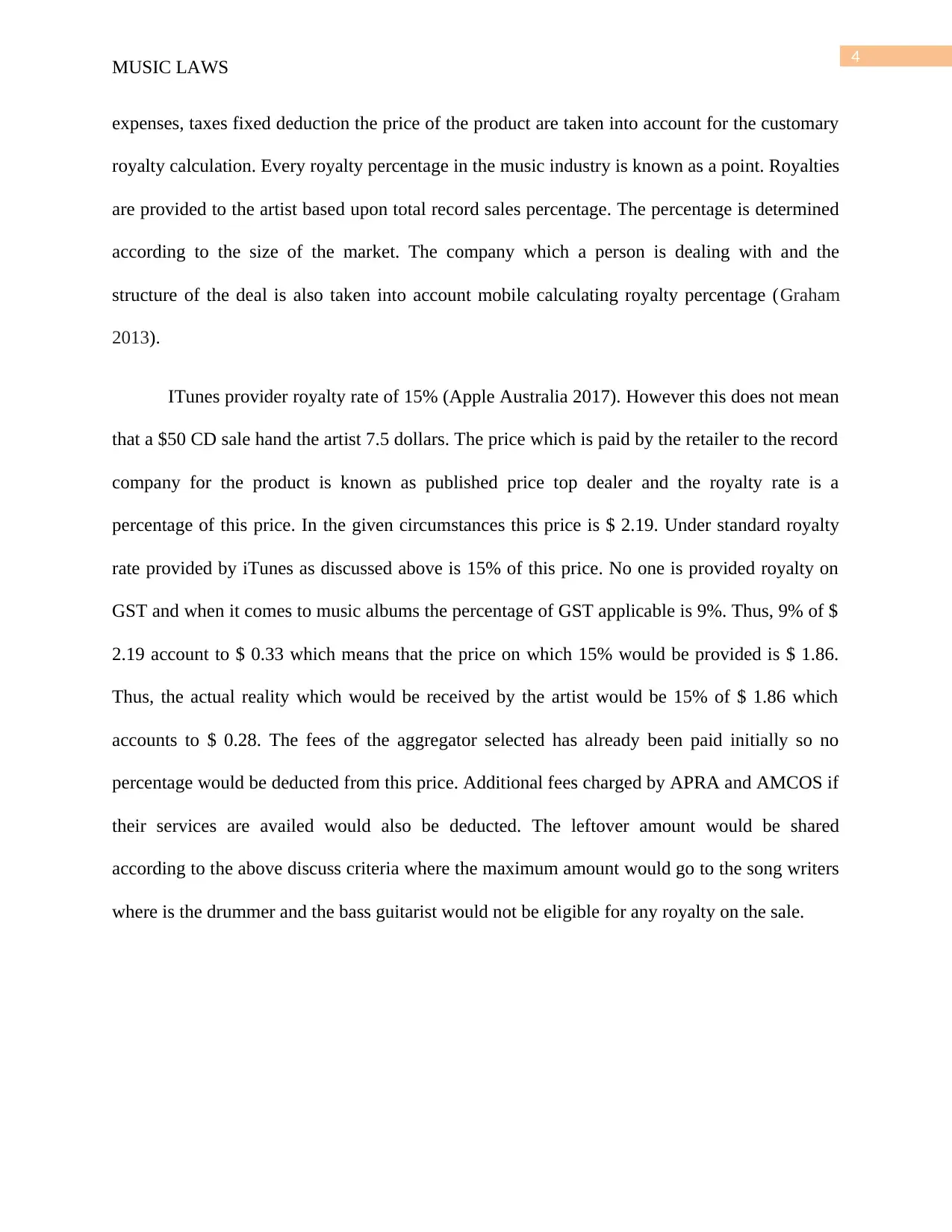
4
MUSIC LAWS
expenses, taxes fixed deduction the price of the product are taken into account for the customary
royalty calculation. Every royalty percentage in the music industry is known as a point. Royalties
are provided to the artist based upon total record sales percentage. The percentage is determined
according to the size of the market. The company which a person is dealing with and the
structure of the deal is also taken into account mobile calculating royalty percentage (Graham
2013).
ITunes provider royalty rate of 15% (Apple Australia 2017). However this does not mean
that a $50 CD sale hand the artist 7.5 dollars. The price which is paid by the retailer to the record
company for the product is known as published price top dealer and the royalty rate is a
percentage of this price. In the given circumstances this price is $ 2.19. Under standard royalty
rate provided by iTunes as discussed above is 15% of this price. No one is provided royalty on
GST and when it comes to music albums the percentage of GST applicable is 9%. Thus, 9% of $
2.19 account to $ 0.33 which means that the price on which 15% would be provided is $ 1.86.
Thus, the actual reality which would be received by the artist would be 15% of $ 1.86 which
accounts to $ 0.28. The fees of the aggregator selected has already been paid initially so no
percentage would be deducted from this price. Additional fees charged by APRA and AMCOS if
their services are availed would also be deducted. The leftover amount would be shared
according to the above discuss criteria where the maximum amount would go to the song writers
where is the drummer and the bass guitarist would not be eligible for any royalty on the sale.
MUSIC LAWS
expenses, taxes fixed deduction the price of the product are taken into account for the customary
royalty calculation. Every royalty percentage in the music industry is known as a point. Royalties
are provided to the artist based upon total record sales percentage. The percentage is determined
according to the size of the market. The company which a person is dealing with and the
structure of the deal is also taken into account mobile calculating royalty percentage (Graham
2013).
ITunes provider royalty rate of 15% (Apple Australia 2017). However this does not mean
that a $50 CD sale hand the artist 7.5 dollars. The price which is paid by the retailer to the record
company for the product is known as published price top dealer and the royalty rate is a
percentage of this price. In the given circumstances this price is $ 2.19. Under standard royalty
rate provided by iTunes as discussed above is 15% of this price. No one is provided royalty on
GST and when it comes to music albums the percentage of GST applicable is 9%. Thus, 9% of $
2.19 account to $ 0.33 which means that the price on which 15% would be provided is $ 1.86.
Thus, the actual reality which would be received by the artist would be 15% of $ 1.86 which
accounts to $ 0.28. The fees of the aggregator selected has already been paid initially so no
percentage would be deducted from this price. Additional fees charged by APRA and AMCOS if
their services are availed would also be deducted. The leftover amount would be shared
according to the above discuss criteria where the maximum amount would go to the song writers
where is the drummer and the bass guitarist would not be eligible for any royalty on the sale.
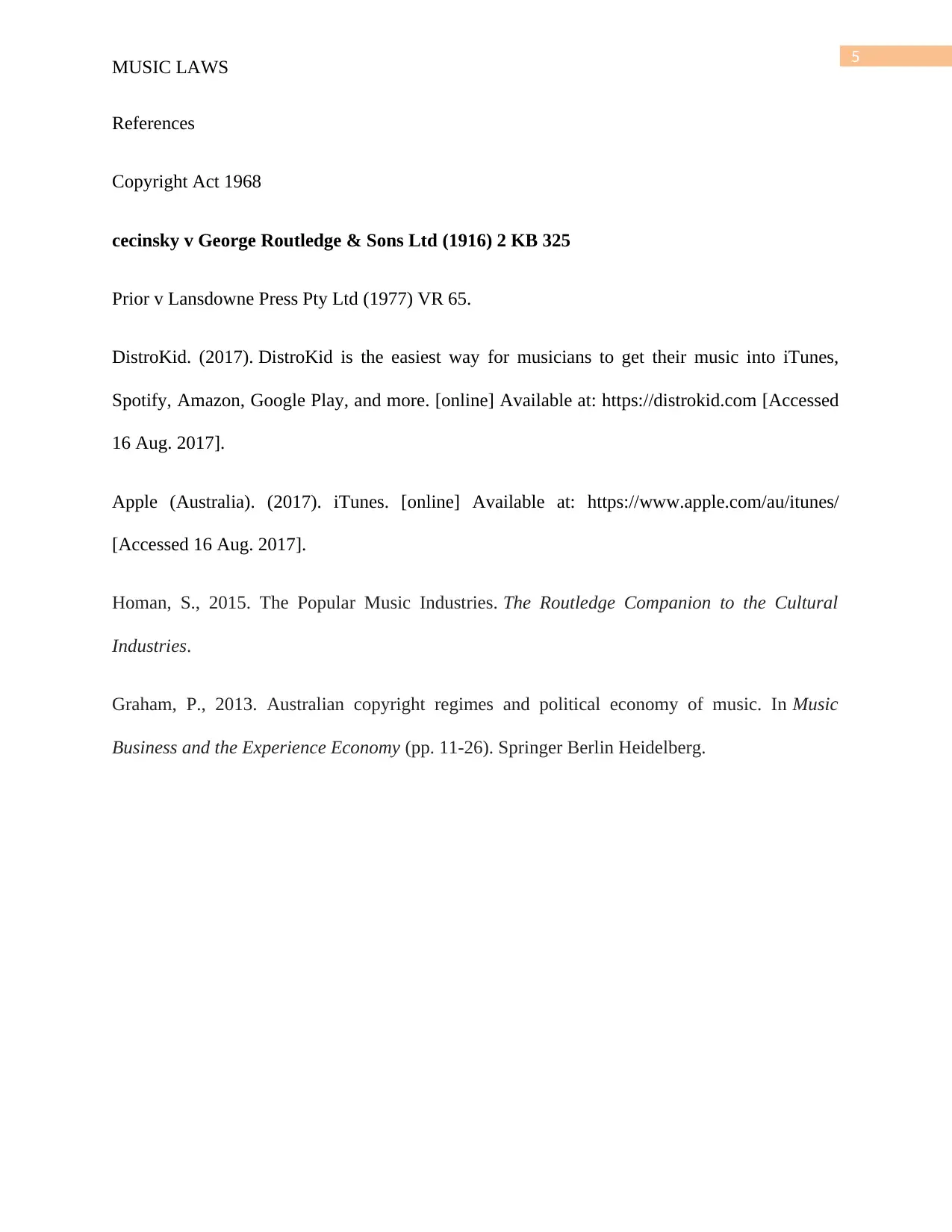
5
MUSIC LAWS
References
Copyright Act 1968
cecinsky v George Routledge & Sons Ltd (1916) 2 KB 325
Prior v Lansdowne Press Pty Ltd (1977) VR 65.
DistroKid. (2017). DistroKid is the easiest way for musicians to get their music into iTunes,
Spotify, Amazon, Google Play, and more. [online] Available at: https://distrokid.com [Accessed
16 Aug. 2017].
Apple (Australia). (2017). iTunes. [online] Available at: https://www.apple.com/au/itunes/
[Accessed 16 Aug. 2017].
Homan, S., 2015. The Popular Music Industries. The Routledge Companion to the Cultural
Industries.
Graham, P., 2013. Australian copyright regimes and political economy of music. In Music
Business and the Experience Economy (pp. 11-26). Springer Berlin Heidelberg.
MUSIC LAWS
References
Copyright Act 1968
cecinsky v George Routledge & Sons Ltd (1916) 2 KB 325
Prior v Lansdowne Press Pty Ltd (1977) VR 65.
DistroKid. (2017). DistroKid is the easiest way for musicians to get their music into iTunes,
Spotify, Amazon, Google Play, and more. [online] Available at: https://distrokid.com [Accessed
16 Aug. 2017].
Apple (Australia). (2017). iTunes. [online] Available at: https://www.apple.com/au/itunes/
[Accessed 16 Aug. 2017].
Homan, S., 2015. The Popular Music Industries. The Routledge Companion to the Cultural
Industries.
Graham, P., 2013. Australian copyright regimes and political economy of music. In Music
Business and the Experience Economy (pp. 11-26). Springer Berlin Heidelberg.
⊘ This is a preview!⊘
Do you want full access?
Subscribe today to unlock all pages.

Trusted by 1+ million students worldwide
1 out of 6
Related Documents
Your All-in-One AI-Powered Toolkit for Academic Success.
+13062052269
info@desklib.com
Available 24*7 on WhatsApp / Email
![[object Object]](/_next/static/media/star-bottom.7253800d.svg)
Unlock your academic potential
Copyright © 2020–2025 A2Z Services. All Rights Reserved. Developed and managed by ZUCOL.





